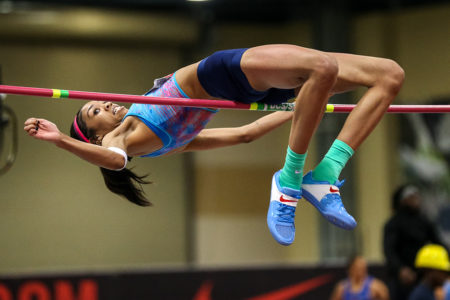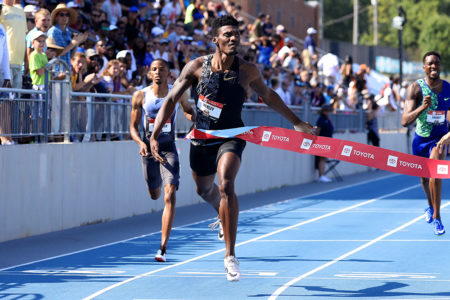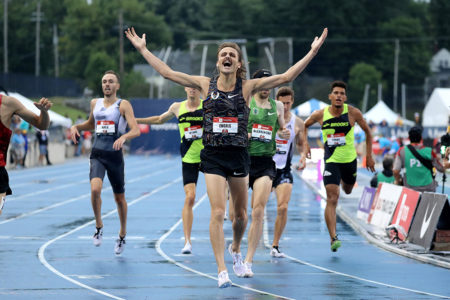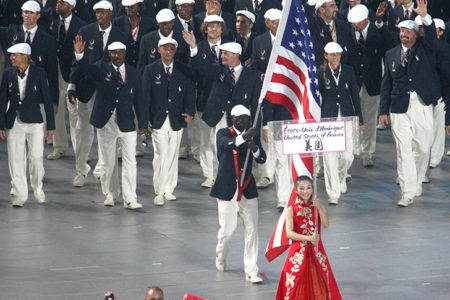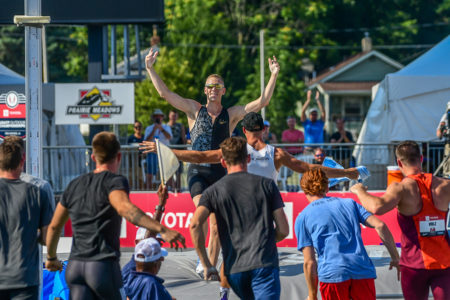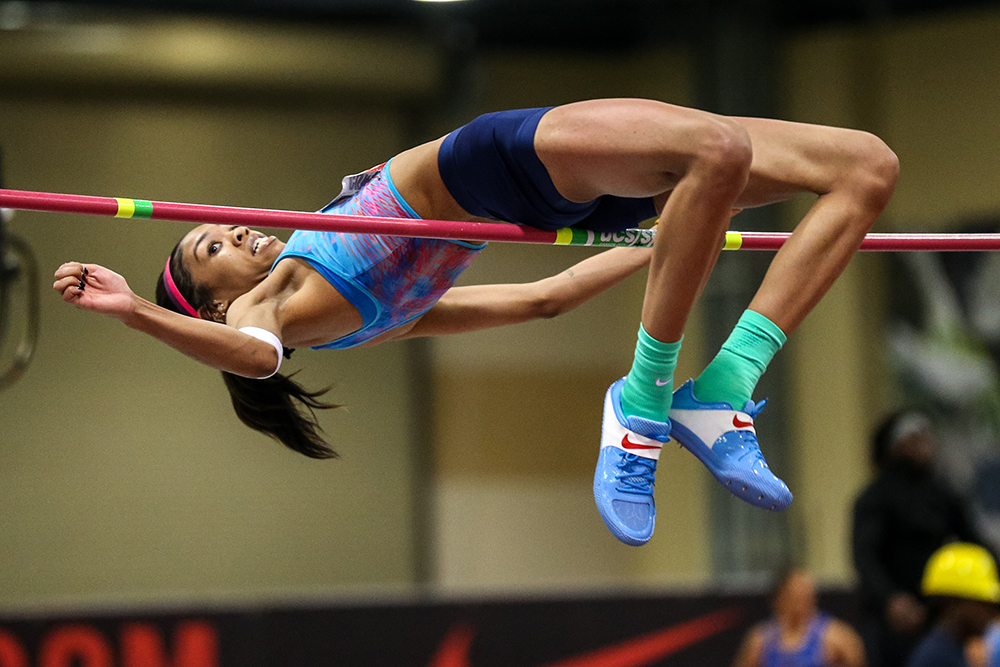
FOR VASHTI CUNNINGHAM, 2-meters (6-6¾) was a long time coming. Her clearance of high jumping’s major barrier came at the Prefontaine Classic, more than 3 years after she cleared 1.99 (6-6¼) to win her first USATF title just weeks before she took World Indoor gold in ’16. That meet, as a high school senior on the brink of turning pro, was Cunningham’s coming-out party. The world sat up and took note: the future was here.
Except that the next few years did not go as those brilliant performances in Portland seemed to prophesy. Not that the Nevada native performed badly. She won 6 of the next 7 USATF titles indoors and out. But what she really wanted—a major outdoor medal as well as higher heights—did not happen on schedule.
Cunningham has continued training in Las Vegas with her coach/father/pastor Randall Cunningham, himself a former All-Pro NFL quarterback. On the cusp of the USATF Championships she took a break to talk to us about 2-meters, upcoming championships, and her role as a veteran while still only 21.
T&FN: Congratulations on jumping 2.00. We haven’t counted up how many times you tried that bar in the last three years, but what did it mean to you when it finally stayed up?
Cunningham: That meant a lot to me. When I first signed with Nike, I went 1.99 and I was 18 years old and I’ve been through like a few bodily changes since then. I’ve sprained both my ankles. I’ve had stomach ulcers. I’ve had ankle surgery. And during that time it could’ve been easy for me to pay attention to what people were saying about how I haven’t PRed in a few years, but I kinda just stayed focused. I was able to look past everything and the time that I haven’t been able to progress. To overcome that stuff and then progress really means that I know I have higher heights to come, that that’s not the highest I’m going to go.
T&FN: Your jumping this year has been very consistent, with an undefeated record until your runner-up finish at Pre behind Mariya Lasitskene. What’s making that happen?
Cunningham: Just me letting my body heal and getting that bone spur from my ankle out. I was jumping with the bone spur since the Olympics and I just got it removed after last season. I really felt like it was restricting my training and my competition. I feel like now that I’ve got it removed I can really push myself more. And last longer.
T&FN: Once you recovered from the surgery, how did your off-season training go?
Cunningham: I would say that was one of my best training seasons. That’s when I started lifting the heaviest and jumping the highest heights I have in practice.
T&FN: On the domestic scene, you’ve been virtually unbeatable. Since 2016 you’ve only lost to an American once. You’ve won 6 of the last 7 USATF titles indoors and out. What does that do for your mindset going into the USATF meet?
Cunningham: It builds my confidence going into the USA meet because to know that I’ve been consistent over the past years, that helps me mentally going into a familiar competition. The familiarity of winning. I like going into a competition that I’ve been to multiple times in the past and that I feel very comfortable at. I always feel like whenever I go to a USA championship that it’s very comfortable not only because of the venue, but just being around all these people who are very familiar to me. And it’s always good energy from my competitors.
T&FN: Back in 2016, you were the youngster out there, the teenage sensation. How has the way your competitors treated you evolved as you have gained experience?
Cunningham: Yeah, I would say back then a little bit, I kind of was treated like the baby. I understand that I was the baby [laughs], but now I think that it’s a little bit different. I think now I’ve kind of earned a little bit more respect and I’m not really looked down on as the baby anymore. And I like that. Some people even have referred to me as a vet and I really, really loved that.
T&FN: Now the global landscape is different than what you see in the U.S. and it’s obviously quite challenging in your event. How do you mentally compete against someone who’s as dominant as Mariya Lasitskene?
Cunningham: That’s a good question. She’s a great jumper and to come into a competition and face her. Since I was in high school, I was always the top high jumper in America. So for me, going against the European high jumpers and getting on the circuit, it’s different because I’m not used to going against girls who are, you know, right up there with me or jumping higher than me. And I’m certainly not really used to losing. So when I go up against Mariya, it’s more of a mental thing that I have to lock into my head: I’m not going against her. I don’t really know about a lot of what’s going on in the high jump and with the athletes overseas and everything. So it’s really to me just remaining confident in my training and knowing that I’ve put the work in and just trusting God to go out there and use me. That’s how I enter a competition with Mariya.
T&FN: She’s famous for how rarely she smiles or shows emotion while she competes. Have you seen a different side of her? Does she relax more for the other jumpers than she does for the cameras?
Cunningham: I haven’t really seen a different side of her. But after Prefontaine I did catch her, she was outside of the track and I was walking to meet my family and I saw her. We don’t usually talk a lot, but I just went over and gave her a hug and she kissed me on the cheek and her mom did too. And that was like the first time I ever experienced like that they liked me [laughs] or that it was a little bit more like happiness. So that was cool to me. I was like, hmmm… “If they like me, then I’ll be a little more open and nice in competition with her.”
T&FN: Your last appearance at the outdoor World Championships [10th, London ’17], I’m sure that was probably a letdown for you in some ways. Has that been in the back of your mind as a motivator for you, leading to Doha?
Cunningham: Yes, of course. I’m very, very motivated for Doha. And I still think about the Olympics, not getting on the medal stand—that still motivates me. Any time that I don’t do as expected, I’m always thinking about that the next time around.
T&FN: Now that you’re a veteran, is the act of going to a meet and jumping still as fun for you as it was when you were a kid?
Cunningham: It’s actually more fun now than it was as a kid. I think when I was younger, I felt a little bit of pressure at track meets and I was a little bit nervous. It was fun and everything back then, but I used to be just… I used to be very mental. Now that I’m older and I’ve built my mental strength up and I’m cool with a lot of the athletes in different countries, I have friends overseas and I have friends from America who are going overseas. For me it’s just very exciting to be in a whole new place with a whole new culture and still look around and there’s some people you know from America that you’re close with. So to me going to a meet is like, it’s more than just the track meet, it’s kind of like the whole process of coming there a few days early, seeing all the familiar faces, getting in the zone, going to a track meet, warming up with everybody, and then afterwards being able to laugh a little bit and have fun with the people that competed as well.
T&FN: I imagine that going into this fall and next year, your goals are sky high, understandably. What do you need to do technically—and psychologically—to make your goals happen?
Cunningham: Technically I need to work on getting my head back when I’m jumping and jumping straight up, fixing my angle a little bit more. Mentally, I need to just tell myself that I need to understand and believe that God can do amazing things that other people can’t do and, and he just wants to use his people to give him glory. So at the end of the day, even if I don’t feel like I’m going to have a good competition, just knowing and trusting that God’s going to come through for me, that’s something that I’m working on building going into the Olympic year. I just need to make sure that I’m doing the right training in the right time for the season and my progressions are on time.
